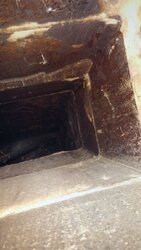Installing insert into existing chimney. House is ~45 years old. I have lived in it for 20 years. When I moved in their was a very used looking pellet stove. I have no idea how many years it was in service. I am providing this information as I inspected the chimney for the first time and was VERY surprised how clean it was. I scraped the sides with a sharp poker and it did not leave any marks.
Although the chimney flue and sides look good, their is about 1"-1 1/2" of ash on the smoke shelf. Some of it is also cement slurry and pieces. Presumably from construction since the flu looks to be in very good condition.
Given the flu ID is 10"x15" and internal, I plan on using a 6" stainless steel liner without insulation. The total flu height from wood stove base to top vent will be about ~14'.
If their is a more economical approach then a stainless liner, please recommend one. I understand some may "slamb" the stove in. Running a new liner for safety is worth it to me. Although insulating it seems unnecessary.
Also, I want to install a "T" for a clean-out. To make space for one, a damper cross brace would need to be removed. The damper is 48" wide and has two cross braces and another cross brace for the damper lever. Is it ok to remove one, maybe even two braces? But leaving the damper frame installed.
Comments and suggestions are appreciated.
Although the chimney flue and sides look good, their is about 1"-1 1/2" of ash on the smoke shelf. Some of it is also cement slurry and pieces. Presumably from construction since the flu looks to be in very good condition.
Given the flu ID is 10"x15" and internal, I plan on using a 6" stainless steel liner without insulation. The total flu height from wood stove base to top vent will be about ~14'.
If their is a more economical approach then a stainless liner, please recommend one. I understand some may "slamb" the stove in. Running a new liner for safety is worth it to me. Although insulating it seems unnecessary.
Also, I want to install a "T" for a clean-out. To make space for one, a damper cross brace would need to be removed. The damper is 48" wide and has two cross braces and another cross brace for the damper lever. Is it ok to remove one, maybe even two braces? But leaving the damper frame installed.
Comments and suggestions are appreciated.






 Although the extra $200 is making me flinch...
Although the extra $200 is making me flinch...